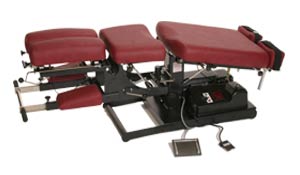Flexion-distraction vs active exercise for chronic low back pain
 “Flexion-distraction [FD] involves the use of a specialized table [see photo] that gently distracts or stretches the spine,” says Dr. Arn Strasser from the Center for Chiropractic & Pain Rehabilitation in Portland, Oregon.
“Flexion-distraction [FD] involves the use of a specialized table [see photo] that gently distracts or stretches the spine,” says Dr. Arn Strasser from the Center for Chiropractic & Pain Rehabilitation in Portland, Oregon.
OK, but how does it compare to an active trunk exercise (ATE) protocol (see photo below) as performed by physical therapists?
 In a study of 235 adults with low-back pain for longer than 3 months, both groups had significantly less pain and better function after treatment according to the results of a visual analog scale (VAS). Overall the FD group did significantly better than the ATE group based on the VAS. Other evaluation tools (ie, Roland Morris Questionnaire [RMQ] and SF-36) showed no difference, however.
In a study of 235 adults with low-back pain for longer than 3 months, both groups had significantly less pain and better function after treatment according to the results of a visual analog scale (VAS). Overall the FD group did significantly better than the ATE group based on the VAS. Other evaluation tools (ie, Roland Morris Questionnaire [RMQ] and SF-36) showed no difference, however.
(Don’t ya just hate acronyms!)
For the record, a VAS uses a 100 mm line where touching it further to the right means more pain and to the left, less pain).
In certain subgroups of patients, one form of treatment was better than the other. But the differences — at least at this point in the research of these two treatment options — seem more apparent than real.
A more detailed review of the study is found here.
1/9/07 21:36 JR